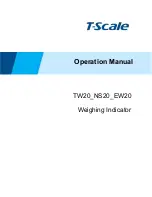
Poseidon SE7EN User Manual
Appendix 3 Page 113
System monitoring
Merely understanding how to read and interpret the information presented on the Poseidon
SE7EN Primary Display is only the first step. All divers must learn to monitor the Primary
Display and alarm systems regularly throughout the dive. In addition to the parameters moni-
tored during an open-circuit scuba dive (e.g., depth, cylinder pressure, decompression status),
a closed-circuit rebreather diver must also monitor other variables, such as the PO
2
of the
breathing gas and the remaining battery life. The SE7EN is designed to make the task of monitor-
ing these parameters as easy and straightforward as possible, and alarm systems have been
incorporated to alert the diver when these parameters drift out of safe range. Nevertheless, it
is vitally important to the safety of the diver that good system monitoring habits be developed.
Monitoring the PO
2
value
The most critical parameter to monitor on any closed-circuit rebreather is the oxygen partial
pressure in the breathing loop. The most dangerous aspect of closed-circuit rebreathers is the
fact that the oxygen concentration in the breathing gas is dynamic and can change. Consider-
ing the lack of reliable physiological warning symptoms for impending hypoxia or CNS oxygen
toxicity, and the severity of these maladies while underwater, the importance of frequent PO
2
monitoring should be obvious. Fortunately, the Poseidon SE7EN is designed to not only
monitor the PO
2
value in the breathing loop, but also validate that the oxygen sensor readings
are correct and accurate. Although there are many alarm systems built into this system, it is
always good practice for divers to regularly monitor the PO
2
value on the Primary Display
screen, to ensure that it is within limits, and that the value itself is not flashing.
Monitoring gas supplies
The next most important parameters to monitor are the gas supplies, represented as bar
graphs on the left and right sides of the Primary Display. In particular, it is important to make
sure that the Air (“Dil”) pressure graph is not flashing. The electronics system will constantly
calculate whether there is enough air supply remaining to allow a safe open-circuit bailout to
the surface. If there is not enough air to allow a safe open-circuit bailout to the surface, the “Up
Arrow” will be displayed on the Primary Display, indicating that the diver should ascend to a
shallower depth.
The oxygen supply pressure should also be monitored to ensure there is a sufficient quantity
of oxygen remaining in the oxygen cylinder to complete the remainder of the dive in closed-
circuit mode. Because these values change very slowly throughout the course of a typical
rebreather dive, there is a tendency to ignore them. As with other important parameters, there
will be warnings issued in case the oxygen supply pressure gets too low; but nevertheless, the
diver should be in the habit of monitoring this value regularly.
Monitoring remaining dive time
As mentioned previously, the Remaining Dive Time (RDT) value is based on several different
factors. The value displayed represents the amount of remaining time (in minutes) for the most
limiting factor. If the limiting factor is remaining battery life, the value will count down consis-
tently, regardless of depth. However, if the limiting factor is remaining oxygen supply, the value
could increase or decrease depending on the rate at which the diver is consuming oxygen.
The value can change even more dramatically (and suddenly) when the limit is based on
remaining no-decompression time. This is because a diver with only a few minutes remaining
at a depth of 30 meters (for example) may well have many more minutes remaining at a shal-
lower depth. Conversely, the remaining minutes may suddenly decrease sharply when depth
increases. Thus, it’s extremely important to monitor this value throughout the dive; particularly
after increases in depth.
Note that the RDT value is NOT an exact value, and it should be regarded as a “recom-
mended” remaining dive time, rather then an absolute remaining dive time. In the event that a
diver inadvertently exceeds the no-decompression limits and the dive requires decompression
stop(s), the RDT value changes to display the remaining total decompression time, as
described previously.













































